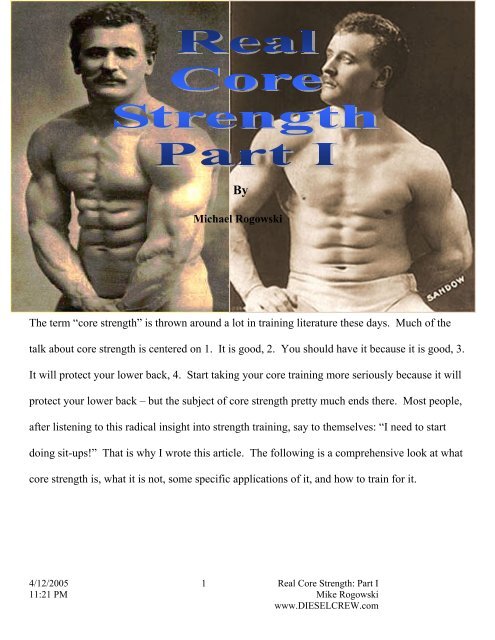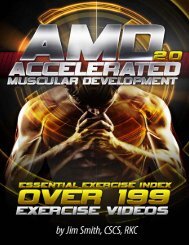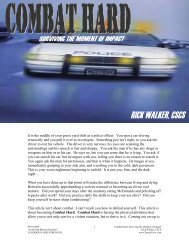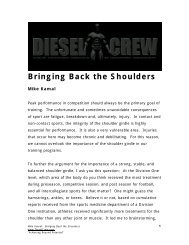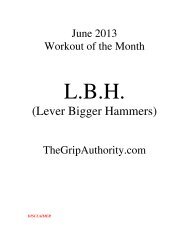Create successful ePaper yourself
Turn your PDF publications into a flip-book with our unique Google optimized e-Paper software.
ByMichael RogowskiThe term “core strength” is thrown around a lot in training literature these days. Much of thetalk about core strength is centered on 1. It is good, 2. You should have it because it is good, 3.It will protect your lower back, 4. Start taking your core training more seriously because it willprotect your lower back – but the subject of core strength pretty much ends there. Most people,after listening to this radical insight into strength training, say to themselves: “I need to startdoing sit-ups!” That is why I wrote this article. The following is a comprehensive look at whatcore strength is, what it is not, some specific applications of it, and how to train for it.4/12/2005 1 <strong>Real</strong> <strong>Core</strong> <strong>Strength</strong>: <strong>Part</strong> I11:21 PM Mike Rogowskiwww.DIESELCREW.com
<strong>Core</strong> <strong>Strength</strong> vs. Abdominal <strong>Strength</strong>In my training scheme I differentiate between core strength and abdominal strength. <strong>Core</strong>strength encompasses many more muscles and muscle groups than just the rectus abdominisand the inner and outer obliques, Another reason I make a distinction is that you can do sit-upsuntil doomsday and still not have the core strength to one hand snatch 100 lbs. without topplingover. <strong>Core</strong> strength involves not only your rectus abdominis, and the inner and outer obliques,but it also involves the transverses abdominus (the muscle that sucks your gut in and out), theintercostals muscles between the ribs, serratus anterior (those ridges that come out from underthe lats), along with the quadratus lumborum and the serratus posterior inferior which are bothdeep muscles of the back.4/12/2005 2 <strong>Real</strong> <strong>Core</strong> <strong>Strength</strong>: <strong>Part</strong> I11:21 PM Mike Rogowskiwww.DIESELCREW.com
Yet another distinction is that the abdominals tend to work synergistic with the hip flexors, coremuscle movements are often synergistic with the hip extensors and leg abductors. With allthese minor muscles involved that do not move independently by your will alone, you shouldstart to get the picture why isolation exercises are useless here. Heavy, systematic movementsare required to train for core strength. Leg raises and sit-ups are good exercises and I do notintend to dissuade you from using them, but they are not building blocks of core strength.4/12/2005 3 <strong>Real</strong> <strong>Core</strong> <strong>Strength</strong>: <strong>Part</strong> I11:21 PM Mike Rogowskiwww.DIESELCREW.com
First Things FirstThe best way to start core conditioning is to not use support equipment, most specifically aweight lifting belt, but support briefs and any type of suit are a big no-no. Now obviouslysupport equipment has its place, especially in contest preparation where the equipment will beused. I have heard others say that a weightlifting belt, and extra support in general, is neededfor heavy partial lifts because it is more than you can lift. I do not train with a belt, even on myheavy partial lifts. I suggest that if you currently use a belt the majority of your exercises toslowly wean yourself off the use of a weight lifting belt in all exercises, including partialmovements. This can mean significant drops in weight on some exercises, but I guarantee itwill produce gains once the equipment is put back on for a test drive. I am not a doctor so Icannot demand that you throw away that knee brace despite your injured knee, but within thebounds of common sense the rule of least support equipment possible and the promise to reducethe amount of use still stands.One Side At A TimeThe majority of core strengthening exercises are done one handed. This imbalance cases thecore muscles of one side to contract in order to keep you upright. Pretty much any standarddumbbell lift that requires you to stand can be converted into a core strengthening exercise.(Using kettlebells in ring weights would be even better than a dumbbell.) Despite hearing these4/12/2005 4 <strong>Real</strong> <strong>Core</strong> <strong>Strength</strong>: <strong>Part</strong> I11:21 PM Mike Rogowskiwww.DIESELCREW.com
words of wisdom, many trainees will by pass this advice due to the extra time it takes in orderto complete basically the same exercise. This is a big mistake. A great deal of untappedstrength can be developed by regularly practicing one handed lifts. A great one handed lifterwill be able to lift significantly more weight than one half the amount one would lift in the twohanded version of the exercise, regardless of the weight implement. This is most true forOlympic style lifts such as the snatch, and clean and jerk because of the driving force of bothlegs goes into one arm, but there is a notable strength gain in strict movements like the onehanded dumbbell curl or a one handed strict press due to the greater amount of tension you’ll beable to generate from your core muscles. Poor one handed lifters will only be able to liftslightly less than half of their best two handed lifts. Your improved technique with the regularpractice of one handed lifts, along with increased core strength will determine just how muchextra force you will be able to apply with that single arm. Doing one handed lifts, each sideback to back is a great way to increase the aerobic workload in your weight training. Howeverwhen going for max attempts, I would advise a normal rest period between right and left handsets.The <strong>Core</strong> of <strong>Core</strong> <strong>Strength</strong>I could not possibly detail every exercise that can be converted into a one handed lift that willprovide you with great gains in core strength. (I have gotten a heck of a core-strengtheningworkout just doing whatever came to mind using a 20Kg kettlebell; get creative.) I will4/12/2005 5 <strong>Real</strong> <strong>Core</strong> <strong>Strength</strong>: <strong>Part</strong> I11:21 PM Mike Rogowskiwww.DIESELCREW.com
however cover some of the big guns in the core strength arsenal and I hope to encourage you tofoster your creativity.Suitcase Deadlifts: Simply put, this is a one handed deadlift that is picked up off the ground atthe right or left of your body. I prefer to use the tricep bars found in gyms due to the shorter,more manageable length, and the displacement of the weight in relation to your grip. If you arefortunate enough to possess a set of beefy dumbbells, go ahead and use those. Somesuggestions on form I have found to increase the core strengthening aspects of this lift are toposition your implement so that your grip is taken at a point where your palm is directlyopposite of your ankle; this places the weight directly in line with your body. It is tempting touse a heavy weight, but I have found to include the core muscles the most, you must choose aweight that enables you to stand perfectly erect. Locking your legs and hips while your torso isstill slumped to one side is not perfectly erect. With these weight levels, pushing against yourleg with your free hand should not be necessary because if you do, you will be unable to standperfectly erect free from assistance with this heavy weight. Keep a firm grip, and do not allowthe weight to begin to turn, which will shift your weight and destroy your form. Hitching is fineas long as you can stand perfectly erect under your own power. One handed farmers walks area variation of this lift. Do not worry too much about the strictness of form for the duration ofone-handed farmers walks. The weight is dropped either after your grip goes or your uprightcarriage has grossly deteriorated from your fatigue.4/12/2005 6 <strong>Real</strong> <strong>Core</strong> <strong>Strength</strong>: <strong>Part</strong> I11:21 PM Mike Rogowskiwww.DIESELCREW.com
The picture on the left is not a good lift, despite the fact that the legs are locked out. The picture on the right isthe proper finished position for suitcase deadlifts and side bends.Side Bends: I’m not talking about those hip twitches with pink dumbbells you see going on incommercial gyms. I’m talking about break out the barbell because the gym dumbbells only goup to 110lbs. Side bends can be trained heavy, and the weights can get really heavy. If youhave not done you side bends heavy before, you may very well double the weight you arecurrently using for this exercise. I like to use triples, starting at a weight I can get five repeasily and working my way up the chain ten pounds at a time until I’m not sure if I will be ableto do a triple and might only get a single repetition. I like a shoulder width stance. Try to keepyour head facing forward. Make sure that you bend at your side in only one plane of motion.Your hand and arm should be perfectly aligned with your torso and your legs; letting the weight4/12/2005 7 <strong>Real</strong> <strong>Core</strong> <strong>Strength</strong>: <strong>Part</strong> I11:21 PM Mike Rogowskiwww.DIESELCREW.com
drift a little in front of you is the easiest way to cheat. This range of motion will feel a littlerestricted. It might even seem like your ribs are ramming into your hips. If so, you are doingsomething right. Now after you have gone down as far as you can go without cheating pull realhard with the obliques of the opposite side. Imagine your ribs being constricted towards yourhip. As you are doing this contract your glutes and lower back like you are locking out adeadlift. Your legs will not move because they are fully extended but this helps you get the bignumbers and it protects your lower back. Also tilt your head in the direction you are trying togo, whether you are rising or going back down; the body likes to follow the head.Turkish Get-Up: As complex as this lift is, the explanation is simple. Lie flat on the ground.With one arm, take a kettlebell, dumbbell, ring weight, or barbell if you are a badass, and fullyextend it (you may use your other hand to help) just like a one handed floor press. (I find itnecessary to use my free hand to press the weight into lockout position because I can do aTurkish get up with more than one half of my best dumbbell bench.) From here you just get up,by any means possible without touching anything but the floor. Yes you can use your free handto help you stand up. You will start off by posting free hand help lift up your torso so you canbring your legs underneath you. Once you get both legs underneath you, stand up. You’re done.It sounds rather simple and the use of your free hand may seem like cheating, but if it is, you’renot using enough weight. You must also be looking at the weight the entire duration of the liftto help make sure it does not wander. The idea is to keep your arm perpendicular with the floorand you accomplish this by making sure you are well underneath the weight, no juxtaposed to4/12/2005 8 <strong>Real</strong> <strong>Core</strong> <strong>Strength</strong>: <strong>Part</strong> I11:21 PM Mike Rogowskiwww.DIESELCREW.com
it. A maximum Turkish get up is a slow, deliberate process that requires precision balancingfrom start to finish. I like to do singles and low reps with these. Doing these for more than fivereps will get you into great shape, but will quickly degrade from training into inhumane torture.An excellent Turkish Get-Up would be your body weight, but that may actually be closer toworld class than excellent.Your first task is to get one leg underneath you. Do this by doing a sit-up assisted by your free hand.4/12/2005 9 <strong>Real</strong> <strong>Core</strong> <strong>Strength</strong>: <strong>Part</strong> I11:21 PM Mike Rogowskiwww.DIESELCREW.com
One Handed Jack Knives: Jack knives are an exercise that is similar to using an ab wheel, butwe’re taking it to the next level by using only one hand with objects that don’t move so easily.Dumbbells, kettlebells, even block weights will work as suitable implements. Gripping yourimplement with one arm, bend over. Now walk your feet backwards as far out as you can gowhile forcing pressure down into the floor with your implement to make sure it does not slide.Improve by holding yourself for longer periods of time and/or extending yourself more, alwaysreaching for the super man position. I like to use kettlebells because they make the exercise somuch more difficult because you must keep the handle of the kettlebell in line with the angle ofyour arm. (I learned this doosy from Brad “The Rafter Man” Johnson.) I don’t like blockweights because it’s easy to rest your hand on top of them instead of gripping them hard on theside like you should. Never cheat by bracing you weight of choice against a wall or anybackstop. If you’re a total badass do these with an underhanded grip on a dumbbell.The small area of surface contact due to the rounded bottom of the kettlebell makes it very challenging to exertenough pressure to keep it from sliding. Though I am not very extended in this picture, it is very challenging ontop of the short carpet. Smaller kettlebells are more difficult than bigger ones to use.4/12/2005 10 <strong>Real</strong> <strong>Core</strong> <strong>Strength</strong>: <strong>Part</strong> I11:21 PM Mike Rogowskiwww.DIESELCREW.com
Reverse Neck Bridge Mountain Climbers: This is an exercise I invented that is an offshootof jack knives. Move into a reverse neck bridge. Try to extend yourself so that your weight ison your forehead and not on the top of your head. Once you are here, raise one leg to yourchest while bending at the knee. Try not to let the moving foot touch the ground. Now bring itback and repeat. I find it helpful to point the toes of the foot that does not move inside. Thisprovides a more stable stance and does not decrease the difficulty of the exercise. Thisexercise will help you in developing the chain from your head all the way down to your toes.Your front neck muscles should have equal difficulty with this lift. If not, one will catch up tothe other in time if you train this exercise.The picture on the left demonstrates the beginning and end of the exercise. The photograph on the right is inmid stride; try to touch your knee to your chest.This is what core strength is all about: Preventing your thoracic and abdominal cavities fromexploding under high pressure. These lifts will try to rip your guts out. My advice is to notallow them to do so.4/12/2005 11 <strong>Real</strong> <strong>Core</strong> <strong>Strength</strong>: <strong>Part</strong> I11:21 PM Mike Rogowskiwww.DIESELCREW.com
Overhead Supports: Take a power rack. Set the pins to the height that you would normallydo overhead lockouts with. Throw your weight lifting belt away, and induce vomiting into atrashcan before you really embarrass yourself. Select a weight near your best overhead lockout,or your best jerk. Space your arms apart in the most comfortable manner that would allow youto press the most weight. Do likewise for your feet position. Grip the barbell and dip your legs,without lifting the bar, straighten your arms into the lockout position. Keep your head forward;looking up will place the pressure of this lift across your chest, where you will fail to lift themost weight possible. Keep your gut tight, kind of like taking a dump but pushing in instead ofdown and out. Make sure your chest is full of air. Drive with your legs in a deliberate, forcefulmanner and maintain your upright position and lockout elbows. Hold this position howeverlong you feel necessary. I personally consider 4 seconds is the minimum time the position mustbe held for a legitimate lift, and anything over 10 seconds means I could be doing more weight.You may find that when you drive your legs up that your body just slides forward or behind thebar, not moving it and inch. There is a delicate, magic spot that your core muscles must keepyou perfectly erect in order to keep you under the barbell. You may have to find that spot everytime you adjust the weight, and with good reason, the zone of success is smaller and smaller asthe weight gets larger. Progress on this lift like you would do your partial movements: youmay like to do one weight for multiple sets or do singles, doubles, or triples until you can’t doanymore weight. To give you an idea of a good lift, my bodyweight is 158lbs. My best clean4/12/2005 12 <strong>Real</strong> <strong>Core</strong> <strong>Strength</strong>: <strong>Part</strong> I11:21 PM Mike Rogowskiwww.DIESELCREW.com
and strict press is 200lbs. My best overhead support is 405lbs. You can spice up this lifting byusing a thicker barbell, which will be more difficult to balance and a heck of a wrist workout.Deep Straddled One Handed Deadlifts: This probably has more to do with lower backstrength than core strength but I can’t think of a more functional implementation of corestrength. You really can’t do these one handed deadlifts with a barbell. You’ll either needsome heavy-duty loadable dumbbells or a loading pin with ring weight. I use the ladder setup.Stand on something (I like to use the gym’s benches when no one is watching.) so that the gripis taken at the level of the bottom of your feet, maybe lower if you can handle it. Get your backand legs all set up in good deadlifting form and pull on the thing like a cartoon character on abroken doorknob. Now with your free hand you can brace yourself by pushing on the leg that ison the same side of the free hand. To save the strain on your hips and lower back, do not go toa full lockout like a two handed dead lift. I advise completing the lift with an upright torsowhile keeping the knees bent. It is tempting to look down at the weight, possibly because it ispulling so much on just that one side it drags your torso with it, but do not. Now since this is aone sided lift, you have to do both sides, but realize it is easy to overtrain this lift. The musclesof the opposite side are working very hard, just not quite the same way. When you have themdo the other side, they are pulling double duty; this is all beside the fact that it will be hittingmuscles you never knew you had and not normally targeted in your training. I have alwaysfound 2 sets per side, for 4 sets total wipes me out worse than a set of high rep heavy squats.4/12/2005 13 <strong>Real</strong> <strong>Core</strong> <strong>Strength</strong>: <strong>Part</strong> I11:21 PM Mike Rogowskiwww.DIESELCREW.com
The picture on the left shows an improper lockout; extending yourself like this with a heavy, imbalanced loadcan really wrench your back. The picture on the right shows the proper end point of the lift. Overtime it willbecome very natural if not locking your legs feels strange to you.Bent Press/Two Hands Anyhow/One Arm Push: These two lifts deserve entire articlesdevoted solely to them and I don’t feel qualified to write that article. However I have studiedand trained these lifts extensively enough to know I cannot fail to discuss them in my articleabout core strength. When people talk about the bentpress, Arthur Saxson, the man who holdsthe world record in two hands anyhow and the bentpress, comes up. Saxson did a bentpress of380lbs. and a two hands anyhow of 448lbs. These lifts are amazing, but also intimidating. Itgives the impression that if you cannot do 200lbs. in either lift you’re no good and wasting yourtime. This is a false mindset. These high numbers can only come from the precision balance4/12/2005 14 <strong>Real</strong> <strong>Core</strong> <strong>Strength</strong>: <strong>Part</strong> I11:21 PM Mike Rogowskiwww.DIESELCREW.com
you can get from a non-revolving cambered barbell. Using other implements like kettlebellsthat have the weight placed in an unfavorable position, and dumbbells that radically shiftbalance if you so much as think to move, will make the bentpress just as tough and heavy as anymonster barbell lift. In addition to needing core strength and arm strength, you will needbrutally strong wrist to lift the big weights with these lifts.Here’s a walk through of the technique of the bentpress: Take your implement to the shoulderby any means you wish, many like to clean it, I prefer to use my free hand to assist. Take astance slightly wider than shoulder width. The leg on the same side of the weight will beperfectly straight and will be kept perfectly in line with it. The opposite leg with be bent andpointing slightly outwards. The forearm of the arm holding the weight will be kept perfectlystraight in line with the leg to form a straight line from your foot to the handle of the weight.Your grip on the implement must be perfectly in line with your torso, forming a 90 degree anglewith straight line made by your forearm and leg. It is easy to tell how inline your grip is with adumbbell or barbell. The free arm will brace against the free leg. Before we begin moving theweight it is of vital importance that your eyes are constantly focused on the weight at all stagesof the lift! This is essential in order to control the implement. Begin to fade away from theweight by bending at the torso. The bend will be slightly forward and in front of your free leg.Bend with your free leg as much as you like. You may find that you will have to stick your hipout in order to maintain that straight line with your working leg and the weight. After you havebent all that you can, you press the weight, and you will press hard. When the weight is ready4/12/2005 15 <strong>Real</strong> <strong>Core</strong> <strong>Strength</strong>: <strong>Part</strong> I11:21 PM Mike Rogowskiwww.DIESELCREW.com
for lockout, bend the leg you have kept straight this hold time, but not so suddenly and so fastthat it upsets your balance. This slight dip and the continued pushing from your arm should beenough to lockout the weight. Now using your free hand to brace against the free leg, bringyourself to standing position. Whew, that was a mouthful, and yes it is that complicated andyou will have to practice a lot.Notice how the load bearing leg and arm in a perfectly straight line perpendicular with the floor. Note theposition of the free hand and the direction of the toes.Notice how both knees are now bent and the arm is now fully extended. Once you are here, push your free handagainst your leg and bring it home. Also note how I am completely focused on the weight once I begin to liftand until I finish.4/12/2005 16 <strong>Real</strong> <strong>Core</strong> <strong>Strength</strong>: <strong>Part</strong> I11:21 PM Mike Rogowskiwww.DIESELCREW.com
To do a two hands anyhow you must grab the second weight implement with the free hand afteryou have locked out the first implement over head. The weight is curled, or cheat curled if youcan manage, as you begin to stand up, and pressed over head once you are fully standing.Holding a heavy two hands anyhow lift overhead is one of the most unique sensations in all ofthe iron game.A two-hand push is a bent press performed with a stance no wider than 18”. Both legs arelocked throughout all of the lift so not nearly as much weight can be lifted in this manner. Thislift is much less technical but requires more flexibility. A slight difference is that you shouldstart to press as you fade away, if not you will have bent to the side so much that your upperarm will be straight and only your triceps will be pressing the weight up. I often will do thesewithout the pressing part and just bend at the sides. I call this the overhead side bend.4/12/2005 17 <strong>Real</strong> <strong>Core</strong> <strong>Strength</strong>: <strong>Part</strong> I11:21 PM Mike Rogowskiwww.DIESELCREW.com
Keep those feet with the proper 18” limit. I find reaching for my toes helps me know when I have reached thefull depth. You may choose to brace with your free hand or not. You may not be using enough weight tonecessitate the assistance of your free hand.Stay tuned for <strong>Real</strong> <strong>Core</strong> <strong>Strength</strong>: <strong>Part</strong> II…4/12/2005 18 <strong>Real</strong> <strong>Core</strong> <strong>Strength</strong>: <strong>Part</strong> I11:21 PM Mike Rogowskiwww.DIESELCREW.com


